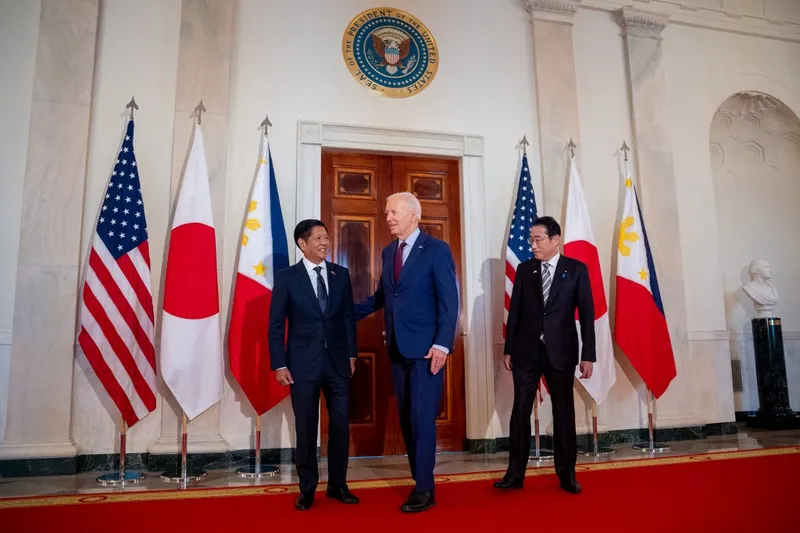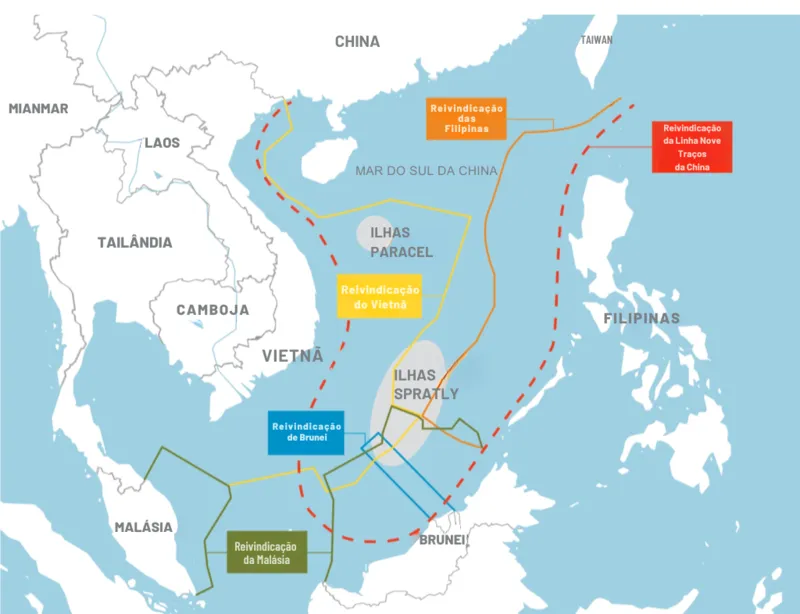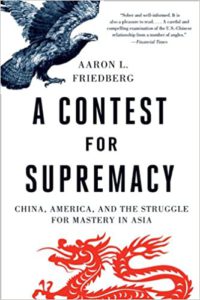U.S. Promotes Growing Military Exercises and New Alliances as Part of Long-Running Plan to Increase Presence in the Region
Mauro Ramos
Beijing|China | April 21, 2024 at 12:25 pm

Tensions in the South China Sea have risen again in recent weeks. In early April, the United States, Japan, Australia, and the Philippines held joint naval exercises in the region for the first time. In a statement, the countries said the exercises demonstrate “a collective commitment to strengthen regional and international cooperation in support of a free and open Indo-Pacific.”
The notion of “Indo-Pacific” promoted by the United States, refers to the combination of countries present in the Indian and Pacific Oceans, and is contested by China (more on this later).
A few days after the exercises, the presidents of the United States, Japan and the Philippines held an unprecedented summit between these three countries at the White House in Washington, which resulted in an agreement on cooperation in several areas, and the promise of an investment of 8 million for communications infrastructure in the Philippines.
At a Pentagon meeting during the same trip, U.S. Defense Secretary Lloyd Austin told President Ferdinand Marcos Jr. that Biden wants congressional approval of $128 million for military projects in the Philippines. Philippine President Ferdinand Marcos Jr. expressed that the unprecedented agreement “should change the dynamics around the South China Sea.”
Anna Rosario Malindog-Uy, a Philippine researcher at the South China Sea Survey Initiative, said the U.S. strategy creates “an atmosphere of a new Cold War that has had a negative impact on countries in the region.”
“I’m very afraid that we’re the next Ukraine or maybe we’re already being a candidate for the ‘new Ukraine’ in Asia. And it’s very dangerous for my country. We will never benefit from all this, it is not in our national interest, because the national interest of my country is economic development, peace and the preservation of our integrity and national sovereignty.”
The Philippines was a colony of the United States for 48 years, from 1898 to 1946. During World War II, and before independence, Japan also occupied the Philippines for 3 years.
“Are we like a semi-colony or are we going back again to the Dark Ages of our history which was colonization by the United States? Is this a 2.0 colonization of my country by the United States? And what’s worse, with Japan. We’ve been colonized by Japan before,” Malindog-Uy said.
Maritime rights
The Philippines claims maritime rights to a part of the sea that China considers to be its own territory. The researcher claims that the Philippine claim is based on the United Nations Convention on the Law of the Sea (UNCLOS).
“What we are saying is that 200 nautical miles [370 km] from our territorial waters, we have exclusive economic rights,” said Malindog-Uy, who is also vice president for external affairs at the Philippine Institute for Strategic Studies.
This area called the Exclusive Economic Zone (EEZ) is provided for in the United Nations Convention on the Law of the Sea. “But the problem is that our EEZ overlaps with China’s claims and China’s claim is bigger, because the claim is to sovereignty. In other words, they are its territorial waters, it is part of its sovereignty. So, given this type of situation, with overlapping maritime and territorial claims, the whole dispute becomes very complicated,” the expert points out.
In 2016, the International Court of Justice in The Hague, in response to a lawsuit filed by the Philippines in 2013, ruled in favor of the Philippine claim. China has refused to recognize the sentence, and said it would follow the path of bilateral talks to resolve the dispute.
China’s claim to the South China Sea is represented by the nine-dash line, originally published in 1947 (before the Revolution), as the eleven-dash line. The claim was reduced in the Gulf of Tonkin area under Mao’s rule in 1957 in favor of Vietnam to a nine-dash line.

The disagreements with the Philippines are historic, but the tenor of the dispute has changed under the administration of Ferdinand Marcos Jr., who a few months after assuming the presidency of the Philippines gave access to four new military bases to the United States, now totaling 9 bases in that country.
For Professor Malindog-Uy, her country has distanced itself from the diplomatic approach of other countries in the region such as Brunei, Malaysia and Vietnam, which also have disputes with China at sea, but follow the line of dialogue with the Asian giant. She attributes this shift to the fact that her country has become a pawn in the United States’ global strategy shift.
“The United States was in the Middle East. When the U.S. emerges defeated from the Middle East, it outlines a strategy of redirection toward Asia. There has been a transfer of military resources and military troops from the Middle East to the Asia-Pacific region,” he explains.
She asserts that the central motivation of this U.S. “Indo-Pacific” strategy has to do with a strategy of containment of China. “The U.S. wants to contain China’s rise, its development as an economy, as a military power, it also wants to politically control China’s growing influence in the region. That is why the United States’ Indo-Pacific strategy is now operational in the Asia-Pacific region.”
“Indo-Pacific”
In 2015, a video that brought together several excerpts of then-candidate Donald Trump saying “China” in his campaign speeches, went viral. It symbolized the growing U.S. stance toward China. Also during the campaign that brought him to the presidency, Trump said: “We are being torn apart by many countries, with China being the No. 1 aggressor.”
Trump’s anti-China tenor intensified, but the overall strategy involving China had been initiated before, especially during Barack Obama’s administrations, with Pivot To Asia. At the same time, investigations were beginning that would result in bans of Chinese companies in the U.S., such as ZTE.
In 2012, Obama Administration Secretary of Defense Leon Panetta announced, “In the coming years we will increase the number and size of our exercises in the Pacific, we will also increase and distribute more widely our port visits, including the important Indian Ocean region.” He made the statement at the Shangri-la Dialogue, the largest military forum in the Asia-Pacific region. Panetta specified that by 2020, the U.S. Navy would go from having its forces evenly distributed between the Pacific and the Atlantic, to a division of about 60%-40%.
In his first year of the Trump administration, several agencies and departments were instructed to work with partners under the idea of a “free and open Indo-Pacific.” That year, during the Asia-Pacific Economic Cooperation (APEC) summit, the then-president said, without mentioning China, that the U.S. would no longer tolerate “cyberattacks, corporate espionage, or other anticompetitive practices.”
The discourse against China became more assertive. In 2019, the U.S. government published the Indo-Pacific Strategy Report, where it states that “as China continues its economic and military ascent, it seeks Indo-Pacific regional hegemony in the short term and, ultimately, global preeminence in the long term.”
During the Trump administration, the Quadrilateral Security Dialogue (Quad) between Australia, India, Japan and the United States was also resurrected in 2017, an initiative that emerged in 2007 and is considered one of the “legacies” of Japanese Prime Minister Shinzo Abe.
The Chinese reject the idea of an Indo-Pacific. “There is no concept like the Indo-Pacific,” is a creation of the United States to attract partners such as India to “contain” China, Chinese diplomat Lu Shaye told The Hindu newspaper two years ago.
Anna Rosario agrees, and says the United States is trying to motivate its traditional allies in many ways, “and also trying to forge this kind of security architecture that is U.S.-centric.” In this regard, she recalls the trilateral dialogue mechanism between the US, Japan and South Korea (which is expected to have a meeting on the sidelines of the NATO summit that will take place in Washington in July), AUKUS (Australia, USA and UK), and the recent mechanism between Japan, the US and the Philippines.
“If you really look at this whole structure, all of this is the embodiment of the Indo-Pacific strategy of the United States, militarily speaking, creating a U.S.-centric security architecture in the Indo-Pacific region, with the goal of containing China but at the same time to have more control in the Asia-Pacific region. The United States is preserving its hegemony and predominance in this region,” argues Professor Malindog-Uy.
Edited by: Leandro Melito
Translated to English
Source: Brasil de Fato
https://www.brasildefato.com.br/2024/04/21/nao-queremos-ser-a-ucrania-da-asia-diz-analista-filipina-sobre-crescentes-tensoes-no-mar-do-sul-da-china
https://www.youtube.com/watch?v=5BXAtavmYyk


